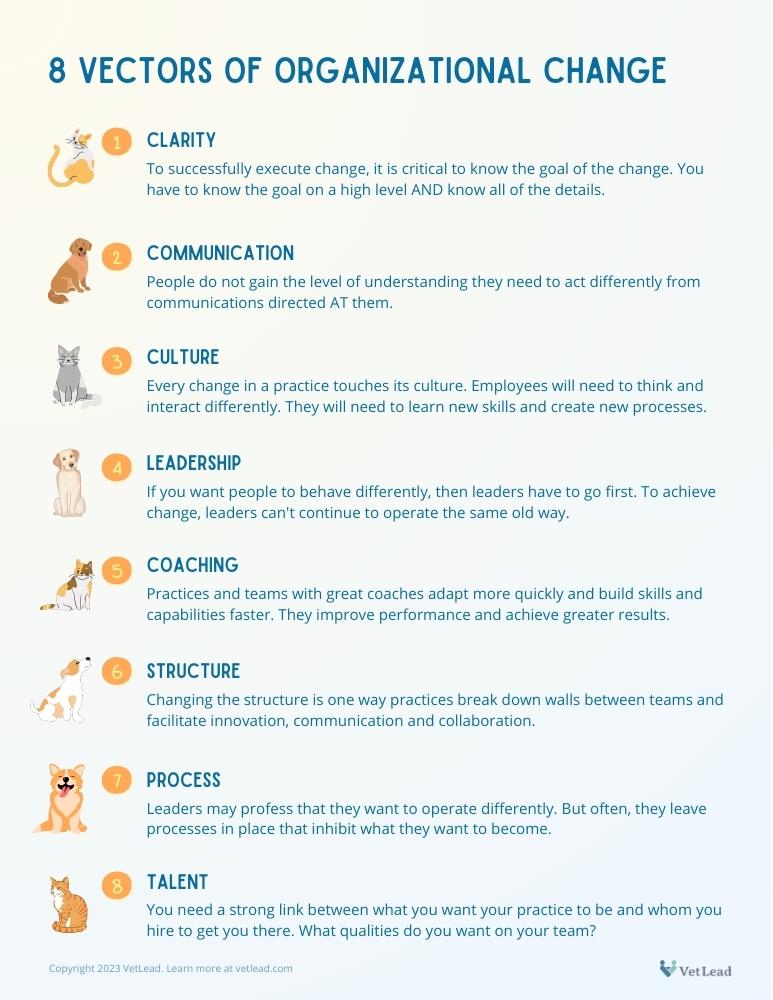Check our the recording of our latest live event, How to Create Insight and Cause Behavior Change in Your Practice.
When I was in college, I initially wanted to be an engineer. I remember learning all about vectors in physics class. A vector is an arrow that represents direction and force. As I work with practices to help them manage change, the same concept comes into play. When a practice wants to change, leaders must manage all forces that affect it.
Leaders also need to ensure that they exert pressure all in the same direction. Many times, practices concentrate on one or two vectors. The remaining vectors actually push back against the very change they are trying to initiate!
There are countless ways to think about organizational change. However, in my experience, there are 8 different vectors that can push for, or against the change. It doesn’t matter if your practice is big or small, the 8 vectors are all present.
8 Vectors of Change in Your Veterinary Practice
1
Clarity
To successfully execute change, it is critical to know the goal of the change. You have to know the goal on a high level AND know all of the details. These details help the team understand how the goal affects them, their job responsibilities and their behavior.
People do not resist change. They resist change they do not understand or they do not agree with. The first step in that process is to clearly define the change. People will then know how to think, act, and prioritize in the future state.
2
Communication
Often, practices create a series of communications that tell the team about the change. What they sometimes fail to do is help each group (front desk staff, kennel assistants, treatment area technicians, associate veterinarians) work through the process of what that communication means for them.
People do not gain the level of understanding they need to act differently from communications directed AT them. They only get there through a series of iterative conversations we have WITH them.
The Veterinary Leadership Program
Get info on this exclusive program.
Learn how to:
- 1Build an accountable team
- 2Make change happen
- 3Improve performance
- 4Hire exceptional talent
Includes live coaching.
Investment will be $897 per person
3
Culture
Every change in a practice touches its culture. Culture may best be defined as the set of organizational habits that currently exist. Habits are hard to change! Employees will need to think and interact differently. They will need to learn new skills and create new processes.
Get ready, because for change to be successful, initially it will become uncomfortable. That means leaders must think about how the culture must shift to execute the new strategy or focus.
4
Leadership
If you want people to behave differently, then leaders have to go first. One of the biggest reasons organizational change fails is that leaders want others to change, but the leaders themselves continue to operate the same way.
This sends a series of conflicting messages to the practice. It essentially tells employees that change is unimportant. They have implied permission to keep doing things the old way. Leaders have to define and execute their own set of new leader behaviors if they want to be a catalyst for change.
5
Coaching
Ultimately, organizational change comes down to individual change. No practice becomes different if its people don’t think and act differently. The greatest lever any organization has to change individual behavior is effective coaching.
Practices and teams with great coaches adapt more quickly and build skills and capabilities faster. They improve performance more consistently and achieve greater results. If you try to drive organizational change without effective coaching, your chances of success are dramatically diminished.
6
Structure
As practices grow, structure must grow with it. Changing the structure is one way practices break down walls between teams and facilitate innovation, communication and collaboration. Leaders should decide on how they want to structure the practice to maximize success and minimize internal chaos.

Download this PDF Now
8 Vectors of Organizational Change in Your Practice
Share it with leaders and teams. No email address required.
7
Process
Leaders may profess that they want to operate differently. But often, they leave processes in place that inhibit what they want to become. There are countless examples of an organization or practice being its own greatest enemy. It comes down to what they want versus how they are organized from a process standpoint.
8
Talent
You need a strong link between what you want your practice to be and whom you hire to get you there. Do you want risk takers, risk avoiders, complex thinkers or intuitive adapters? You may need all of these types of people! If that’s the case, it’s critical to hire leaders who can fully engage a diverse team and move them forward.
Too often, practices try to lead change without giving enough thought to what the future talent needs to look like. Leaders may constantly recruit using yesterday’s philosophy, while trying to build tomorrow’s practice.
Conclusion
Change isn’t easy in any practice. By definition, a practice is built, trained and organized to act exactly like it does in its current state. But if you plan for change, keep these 8 vectors in mind. Get them all exerting force in the same direction. Then, you can make change happen faster and easier. Otherwise, you are fighting against the very practice you are trying to change.
What do you think? Let us know in the comments section below.

